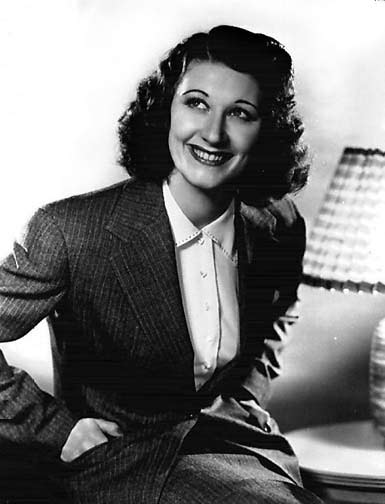Joan Davis (Madonna Josephine Davis)

Joan Davis’ first film was a short subject for Educational Pictures called Way Up Thar (1935), featuring a then-unknown Roy Rogers. Educational’s distribution company, Twentieth Century-Fox, signed Davis for feature films. Tall and lanky, with a comically flat speaking voice, she became known as one of the few female physical clowns of her time. Perhaps best known for her co-starring turn with Bud Abbott and Lou Costello in Hold That Ghost (1941), she had a reputation for flawless physical comedy. Her pantomime sequence in Beautiful But Broke (1944) was a slapstick construction-site episode. Not to forget TAILSPIN (1939) as a supporting actor, for the women’s Bendix Air Race circuit. She co-starred with Eddie Cantor in two features, Show Business (1944) and If You Knew Susie (1948). Cantor and Davis were very close offscreen as well. Joan Davis entered radio with an August 28, 1941, appearance on The Rudy Vallee Show and became a regular on that show four months later. Joan Davis then began a series of shows that established her as a top star of radio situation comedy throughout the 1940s. When Vallee left for the Coast Guard in 1943, Davis and Jack Haley became the co-hosts of the show. With a title change to The Sealtest Village Store, Davis was the owner-operator of the store from July 8, 1943, to June 28, 1945, when she left to do Joanie’s Tea Room on CBS from September 3, 1945, to June 23, 1947. Sponsored by Lever Brothers on behalf of Swan Soap, the premise had Davis running a tea shop in the little community of Smallville. The supporting cast featured Verna Felton. Harry von Zell was the announcer, and her head writer was Abe Burrows, formerly the head writer (and co-creator) of Duffy’s Tavern and eventually a legendary Broadway playwright.
The tea shop setting continued in Joan Davis Time, a CBS Saturday night series from October 11, 1947, to July 3, 1948. With Lionel Stander as the tea shop manager, the cast also included Hans Conried, Mary Jane Croft, Andy Russell, the Choraliers quintet, and John Rarig and his Orchestra. Leave It to Joan ran from July 4 to August 22, 1949, as a summer replacement for Lux Radio Theater and continued from September 9, 1949, to March 3, 1950. She was also heard on CBS July 3 through August 28, 1950. She was a frequent and popular performer on Tallulah Bankhead’s legendary radio variety show, The Big Show (1950–52). When I Love Lucy premiered in October 1951 on CBS Television and became a top-rated TV series, sponsors wanted more of the same with another actress who wasn’t afraid of strenuous physical comedy. I Married Joan premiered in 1952 on NBC, casting Davis as the manic wife of a mild-mannered community judge (Jim Backus) who got her husband into wacky jams with or without the help of a younger sister, played by her real-life daughter, Beverly Wills. I Married Joan did not nearly achieve the ratings success enjoyed by I Love Lucy, but during its first two years it received moderately successful ratings, even cracking the top 25 for the 1953–1954 season. However, by the start of its third year, not only were the ratings beginning to slip, but Davis was beginning to experience heart problems. As a result, the series was canceled in the spring of 1955. Ironically, in its original syndicated run, the series was extremely popular and received high ratings. After Davis died in the spring of 1961, most if not all local TV stations at the time removed the show from their line-ups as a matter of taste—laughing at someone who had just died.
In 1956, a year after I Married Joan had ended its prime-time run, Joan Davis was approached by ABC to star in another sitcom called The Joan Davis Show. The premise of this proposed series had Davis playing a musical comedy entertainer who had raised a daughter on her own. Davis used her real name as the lead character. Veteran character actress Hope Summers was cast as Joan’s housekeeper, and Davis’ daughter Beverly Wills was signed to play Joan’s daughter, also named Beverly. Child actor Ray Ferrell was cast as Joan’s grandson Stevie. In the pilot, Joan was being introduced to her five-year-old grandson for the first time and was trying to convince Beverly that, despite her hectic show-business schedule and her somewhat zany personality, she was a loving and responsible grandmother. The pilot did not sell as a series for ABC. It was virtually forgotten among Davis’ television work until many years later when the Museum of Television & Radio in New York discovered the program and added it to its collection. On May 22, 1961, Davis died of a heart attack at the age of 53 at her home in Palm Springs, California. She was interred in the Holy Cross Cemetery mausoleum in Culver City, California. On October 24, 1963, Davis’ mother, daughter Beverly Wills, and two grandchildren were all killed in a house fire in Palm Springs, California. Joan Davis has two stars on the Hollywood Walk of Fame, one for her contribution the motion picture industry at 1501 Vine Street and one for her radio contribution in the 1700 block of Vine.
Born
- June, 29, 1907
- USA
- St. Paul, Minnesota
Died
- May, 22, 1961
- USA
- Palm Springs, California
Cause of Death
- heart attack
Cemetery
- Holy Cross Cemetery
- Culver City, California
- USA



